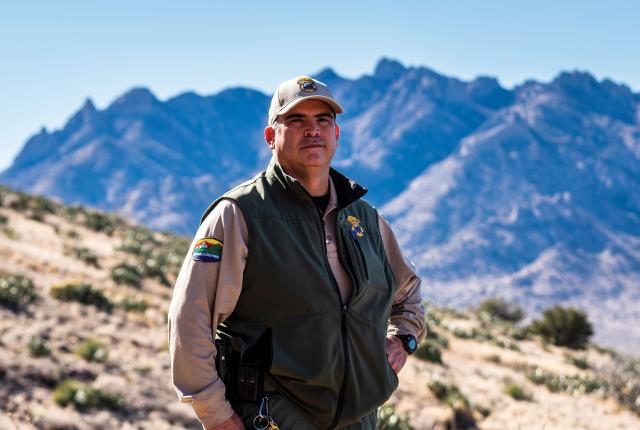Above: Robert V. Apodaca. Photograph by Jay Hemphill.
ROBERT V. APODACA WOULDN'T CALL HIMSELF a rockhound. Yet for nearly 12 years, the self-proclaimed history buff has managed a destination that attracts 80,000 gemstone-hungry visitors annually. His career with New Mexico State Parks began 26 years ago at Caballo Lake State Park, just south of Truth or Consequences, where he still moonlights as a law enforcement ranger. Before that, Apodaca had been working on the road until a seasonal gig opened at Caballo Lake. Later he moved to Deming for a full-time position at Pancho Villa State Park. After a dozen years there and two at City of Rocks State Park, Apodaca made his home at Rockhound, where the administrator has learned to wear many hats: maintenance man, groundskeeper, trail worker, construction manager, event coordinator, and even concierge.
I think New Mexico by far has the broadest variety in what its parks offer. Rockhound has 1,100 acres in the foothills of the Little Florida Mountains, plus our bonus Spring Canyon Recreation Area. The Floridas formed during a volcanic eruption period. The Big Florida Mountains were the uplift, and the Little Floridas are sediment.
Rockhound was established over 50 years ago as the first park in the U.S. to allow rock collecting. Everyone thinks the rocks have been picked over, but there are still plenty of gems and minerals to be found on the mountain. Heavy erosion farms them up, so every rain reveals new rocks. Monsoon season is prime for rockhounding—once the washes and ravines dry out.
We have perlite, quartz, and rhyolite, which looks like petrified wood. Jasper is plentiful. The hunt is for geodes and thunder eggs. A geode has an air pocket, and a thunder egg is a solid crystal form.
We encourage surface collecting. When I first got here, there weren’t black-and-white parameters around rockhounding. People would see part of a rock sticking out of the ground and they’d try to pry out the two-foot-wide stone, putting craters in our trails. Once we noticed a man coming every day with a five-gallon bucket. We had to draw the line. Our management plan now says visitors can use tools up to 12 inches long—basically rock hammers—and take a few rocks just for personal enjoyment.
Our 29 camping sites are full most every night between October and April. We have folks who winter here, bouncing between Rockhound, City of Rocks, and Pancho Villa state parks in 14-day stints. Our snowbirds leave around when the poppies come out in full force.
If we get a wet winter and the stars align, we’ll have a pretty good poppy growth. Seeing this yellow haze on the mountain is pretty picturesque. The landscape blooms through May.
Our friends group developed a native garden to help visitors identify plants found along Rockhound’s four hiking trails. The Jasper Trail from the visitor center intersects with the Thunder Egg Trail, where most people search for rocks. Spring Canyon Trail makes a loop, and Lover’s Leap Trail climbs from 2,500 to 6,000 feet in a mile. At the summit, you can see down the other side of the Floridas to Deming’s agricultural fields.
In Spring Canyon, use all your senses to spot gravity-defying Persian ibex—nonnative goats introduced in the 1970s. Ibex are more active at dawn and dusk. Fixate on the mountain and look for movement. Listen for pebbles tumbling from the bluffs.

SEE FOR YOURSELF
April 11–12, Desert Alive showcases Rockhound through interpretive programming and a native plant sale. Star parties occur on the third Saturday of the month in April and May.


